Net-Zero Hero: Kiana Salazar
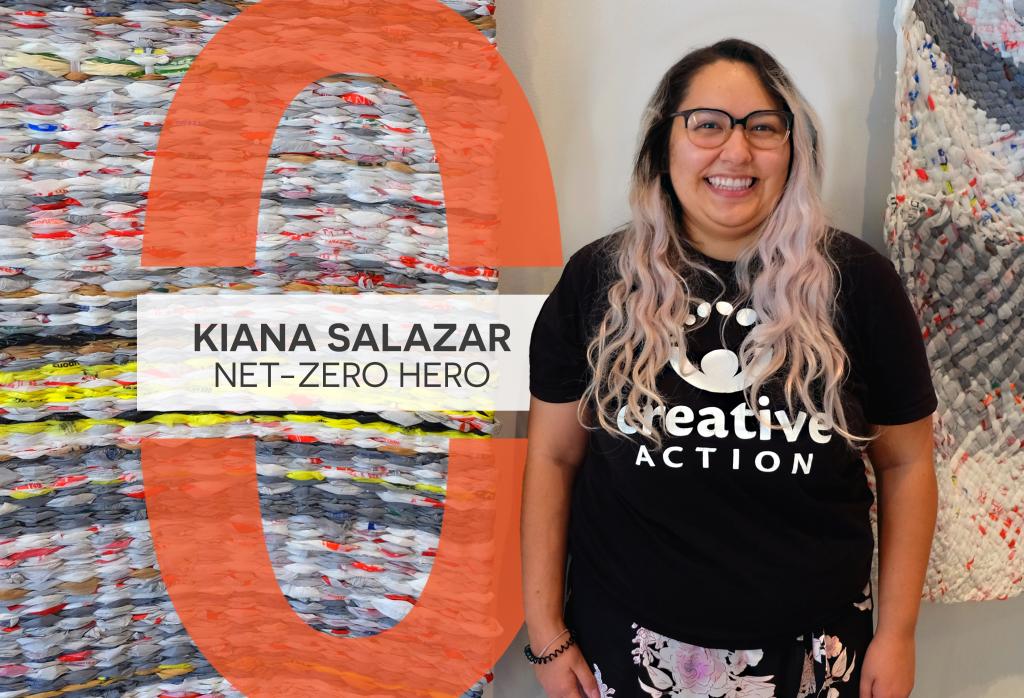
I’m helping to make Austin Net-Zero by weaving plastic grocery bags into sleeping mats for unhoused people.
Meet our newest Net-Zero Hero: Kiana Salazar, an artist and AmeriCorps member using her creative skills for good. Through the AmeriCorps program, Kiana served with local nonprofit Creative Action, whose mission is to “use the arts as a medium to inspire creativity, unlock potential, and transform the lives of students of all ages.” Over her service year, Kiana was tasked with designing and facilitating a project for students that aligned with Creative Action’s mission and supported the larger Austin community. Inspired by a social media post she had seen years earlier, Kiana’s project turned discarded plastic grocery bags into woven mats to give to unhoused people in Austin.
As she closed her year with Creative Action, we met with Kiana during a community weaving circle she facilitated, where we learned how to create the woven mats and spoke with her about her experience with the project.
What inspired you to take action?
I began a new role with AmeriCorps at Creative Action, a nonprofit where my job was to do arts-based community service projects with students. I initially had some other project ideas that were not feasible due to budget constraints, so I had to think of other options. A few years ago, I saw something on social media about people in another state weaving sleeping mats out of grocery bags for the unhoused community. I really wanted to do it back then but never carried out any plans. I don’t know how the idea came back to me after several years, but once it did, I knew that this was the project I wanted to do with my students.
Best of all, the project was using (mostly) free materials that would otherwise be considered trash. I was glad that this project would not only directly benefit people in need, but it would also help to protect the environment from single-use plastic pollution.
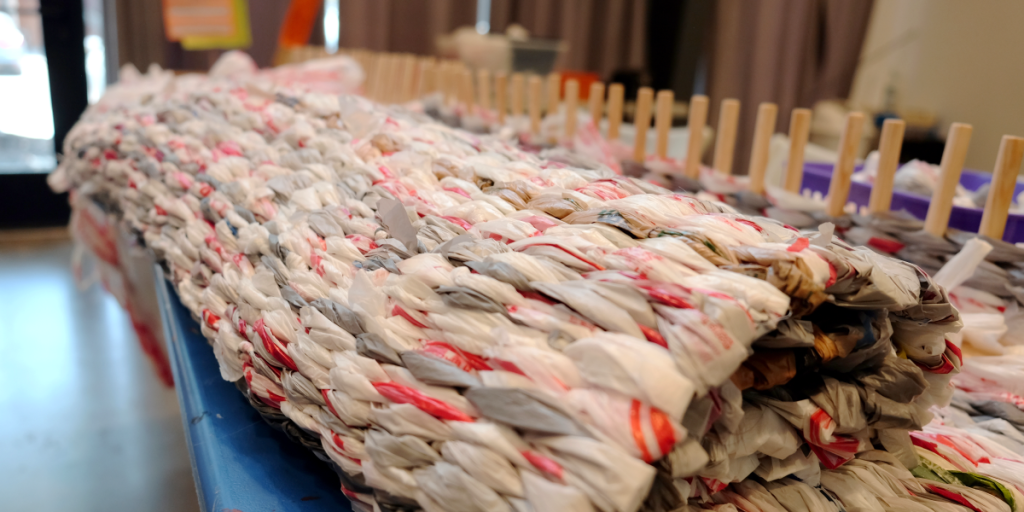
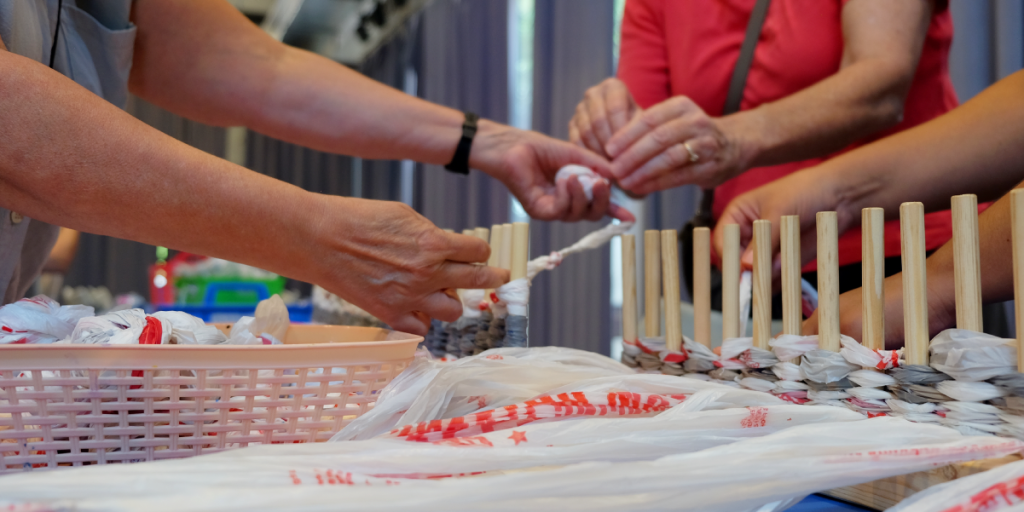
Top: A nearly completed mat rolled up on the loom. Bottom: Community members work together on a loom.
How did you do it?
I started off by speaking with management about my project plan and asked about setting up a bag donation bin. I spoke with the supply manager at work, who already had a nice donation bin not being used. We set it up for plastic grocery bag donations, and I sent out an email to all staff about the project and asked for donations. Donations from our staff soon started pouring in. I would have to empty the bin every week or two as it would become full of bags. Occasionally, when donations were running low or if we had new hires, I would send out a reminder that I was still collecting bags, and by the next day, the bin would be full again. We would also collect donations from students’ families at various schools and public events. Some of my family members also saved their bags to give to me whenever I visited.
Before we could begin weaving the plastic bags into sleeping mats, we had to take some long steps to prepare. First, we had to have enough bags to begin working with. While donations were coming in, I began to introduce my students to the project and teach them how to weave. We practiced tying our shoes, braiding yarn, and paper weaving. We also learned about the different reasons why someone might become houseless and why they might remain in that situation. My students explored the concept of home and shared the things that help them feel safe at home.
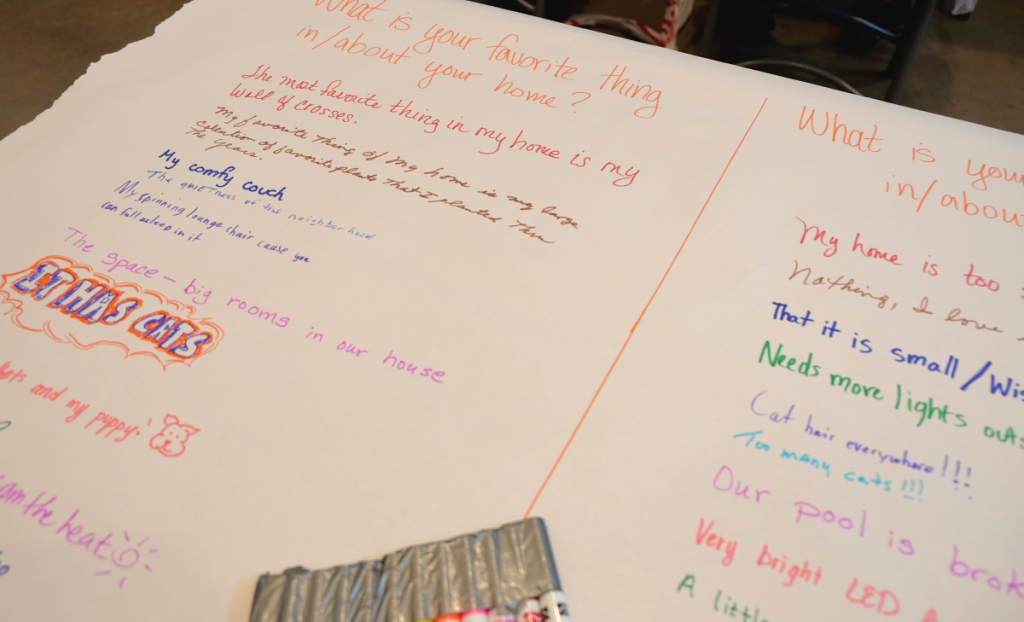
Reflections on home from attendees of the community weaving circle.
When we had enough bags to start weaving, we got to work by cutting and tying bags into long strips of “plarn,” or plastic yarn. I learned how to do this from YouTube videos and articles. Students worked together by delegating tasks and connecting their plarn strips to make them even longer. These plarn strips were so long that they went all the way down the school hallways and around corners! When rolled up, the longest plarn strips were bigger than our heads!
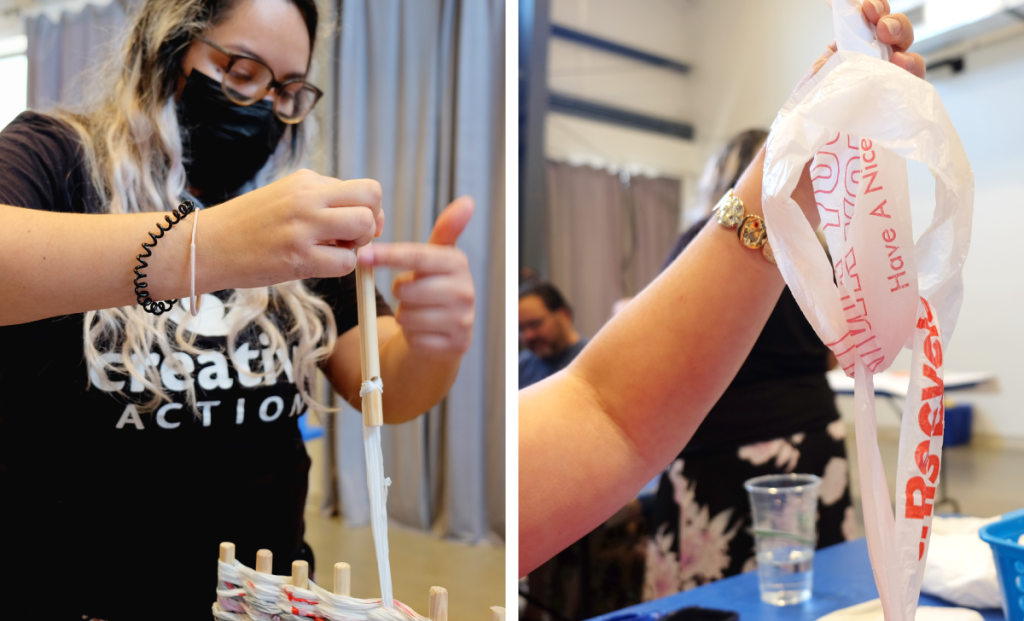
Left: Kiana demonstrates how to finish a row on the loom. Right: Pulling plastic bags together into plarn.
When we first began weaving the bags, we were following a 6- and 10-strand braiding technique that only required our hands. My supervisor and I each made one sleeping mat using this method. Later on, I decided it would probably be best to use peg looms to weave, which are portable, lightweight, and easier to use than braiding by hand. I was able to purchase materials and begin constructing the peg looms. I had some help from friends who let me borrow a few tools and also volunteered to woodwork with me to get more done. Students and coworkers would also volunteer to help sand down the edges of the wooden pegs during recess and free time. Making the looms was a lot of work, and I am still making some, but all the help that people offered made things move along much more quickly. I prefer working with the peg looms over hand-braiding because it’s easier to see the pattern, and it kind of forces the shape of the woven mat to be a flat rectangle. By contrast, when hand-braiding, it is very easy to end up with some uneven curves, and you have to hold a lot of plarn strands in your hand at once.
Through the project so far, our community has saved over 10,000 plastic bags from ending up in landfills, polluting the environment, and poisoning wildlife.
What’s been most rewarding about getting involved in this way?
It was beautiful to see the way that my community has come together for a good cause. What has been most rewarding is to see my students and friends learn new skills they can transfer to other situations. It is amazing to see children as young as four and five years old learn to weave. It was also great to see the way some groups and partners chose to split up duties during a weaving session. Many times, people will decide that while one person cuts up bags into strips, another can be tying those strips together. Some people prefer one task over the other, so it works out that we get to do what we are comfortable with. So far, over 200 people have participated in weaving a mat. And countless others have saved and donated their plastic grocery bags instead of throwing them away or trying to recycle them in their city curbside bins, which are not meant for collecting this type of plastic (You must recycle plastic bags at participating retailers or take them to the Recycle and Reuse Drop-Off Center).
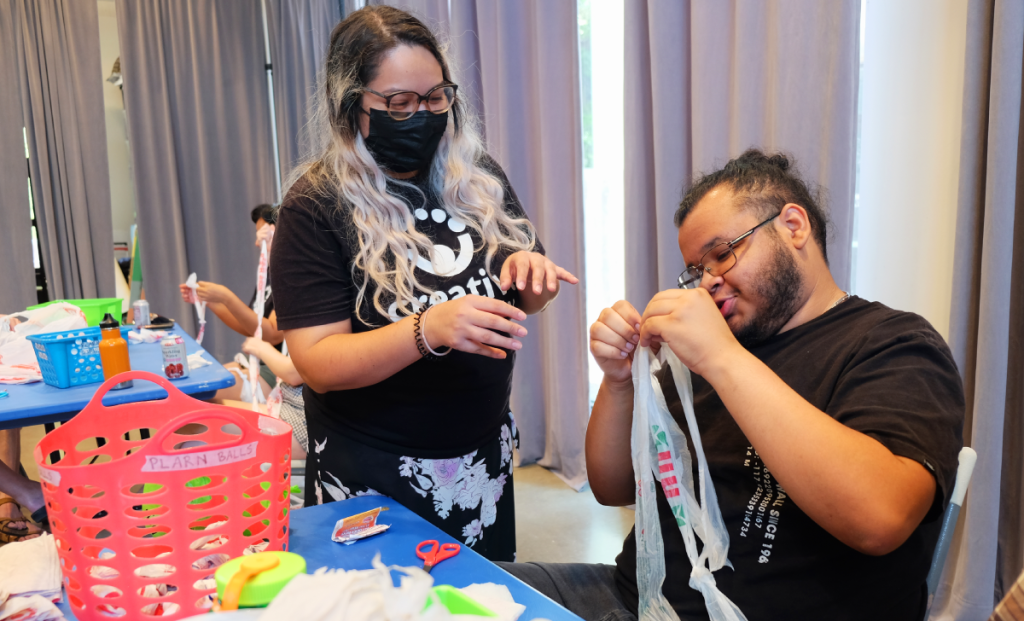
Kiana helps a participant at the community weaving circle create a ball of plarn.
People also tell me that weaving is a relaxing and therapeutic activity. Once you get the hang of it, you don’t have to think about it too much, and you end up getting into a rhythm. You can keep your hands occupied while watching TV, on public transportation, and even in meetings. I spend a lot of time fidgeting if I’m sitting or standing still, and this helps me stay calm while also getting useful work done.
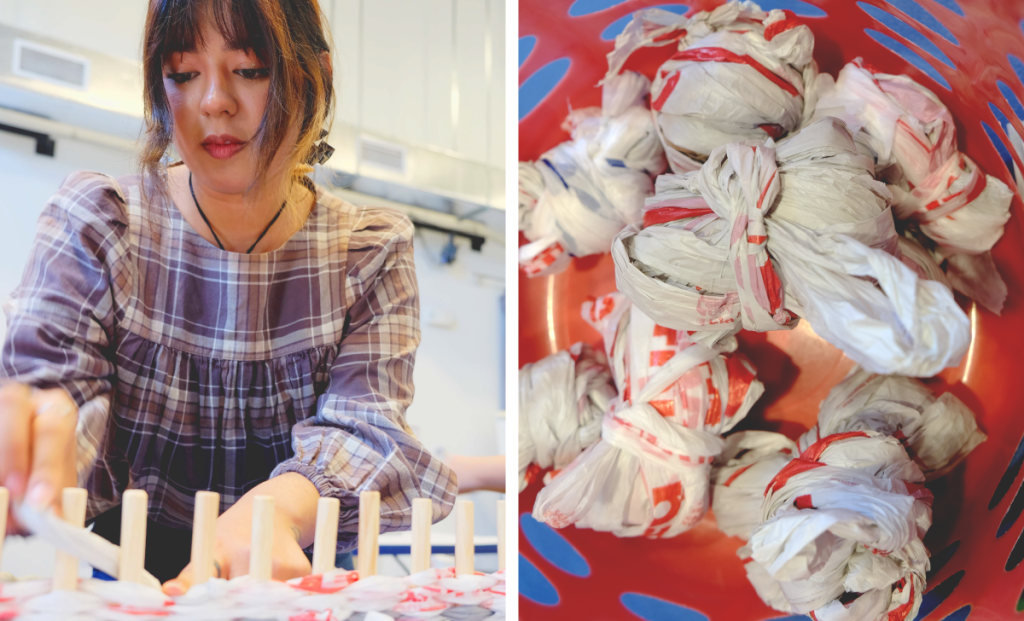
Left: An attendee at the community weaving circle works on a loom. Right: Plarn balls ready to be used.
What’s been the toughest part?
A challenge that we faced was trying to get a lot done in a relatively short amount of time. As an AmeriCorps member, I had slightly less than a year in this temporary role to facilitate this community service project with my students. I thought that we would have completed many more sleeping mats by now. What has been toughest is knowing that we can’t help everyone who is houseless. There are over 2,000 unhoused people in Austin, and over 1,000 of them are unsheltered. A plastic bag sleeping mat will not replace a house or a bed, but at least it can provide some comfort.
What do you see as the role of artists in the climate movement?
I think everyone has a responsibility to protect the environment. I feel like artists can sometimes find themselves in a strange position, grappling between not wanting to create waste but still wanting to create art. Using traditional materials to create various pieces of art could result in a lot of waste left over. Depending on the scale of projects, there will be a difference in the amount of waste and pollution created from a small painting versus a large piece of public art. I don’t think people should stop creating art, however. I think artists need to be conscious of what materials they are using and consider the purpose their art will serve. I think it would be best to try to use recycled or found objects as often as possible. Not all projects can be done using these materials, but it can be very rewarding to create something beautiful and/or useful out of something that would have been discarded.
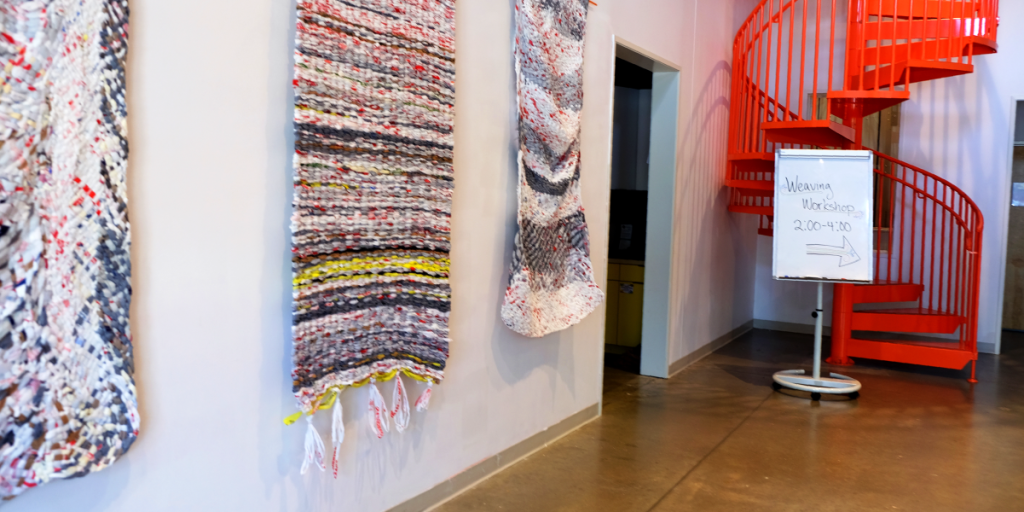
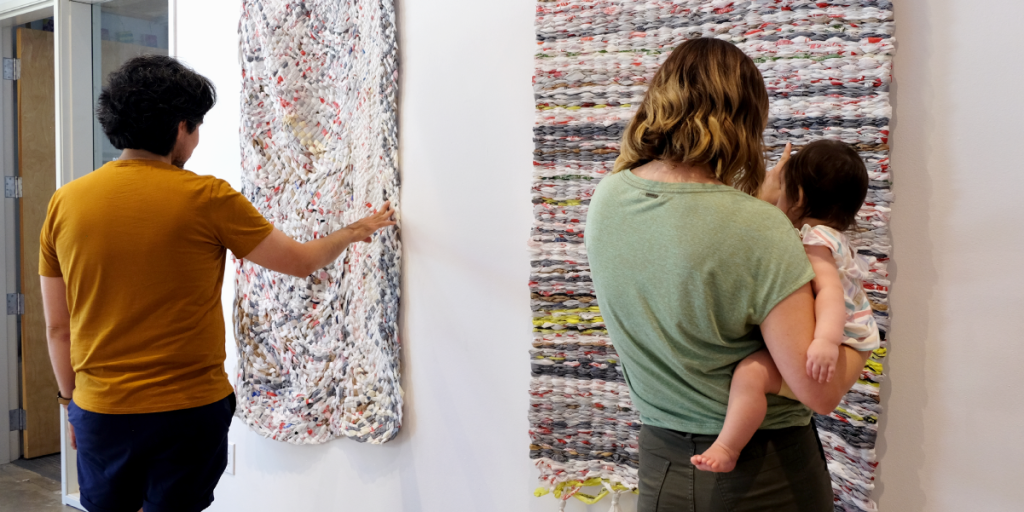
Top: Woven mats hung in Creative Action’s UpFront Gallery. Bottom: Gallery visitors interact with the finished mats.
What is next for you? Do you have another project in mind?
Even though my AmeriCorps service year has ended and I am transitioning into a new job, I still plan to collect and weave plastic grocery bags into sleeping mats for unhoused people as long as I am able. I don’t see a reason to stop. I am trying to coordinate with some venues that would be interested in hosting weaving circles so that the community can continue to be involved. I am also currently working on a few murals in Austin that will help beautify a public space and promote community engagement. I hope to connect with many more community members who want to participate in these projects.
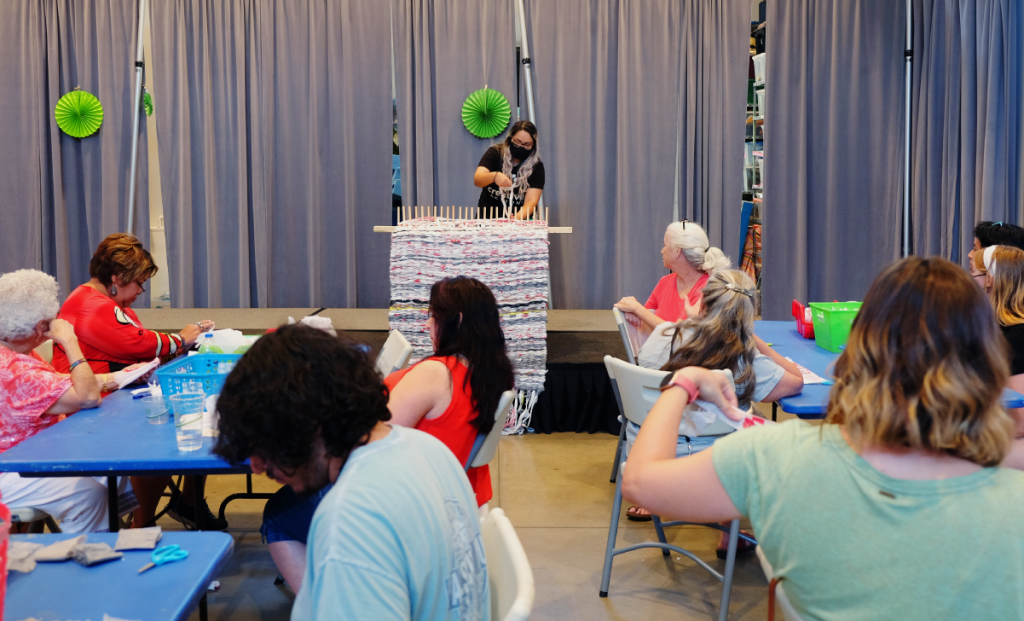
Kiana demonstrates the weaving technique for a community weaving circle.
Is there a book, documentary, or other piece of media you would recommend for folks wanting to learn more about these topics?
I researched how other people have done this project using the following links:
- YouTube: How to Make a PLARN Bed Roll
- YouTube: How To Make Plastic Bag Sleeping Mats (Where You Live)
- Oxford Observer: Bags to Mats Program Turns Trash into Treasure for the Homeless Community
- The Savvy Age blog: Turning Plastic Bags Into Sleep Mats For Homeless
- YouTube: Plastic Bag Rug Without Crocheting
- YouTube: Braided Plastic Bag Rug Part 1
I learned how to make and use peg looms with the following links:
- YouTube: How to Make a Peg Loom
- YouTube: Building a Peg Loom
- Wooly Wormhead blog: How to Make Your Own Peg Loom
- YouTube: Good Shepherd Church - How to Peg Loom with Plastic Bags
- YouTube: Peg Loom Plastic Bag Rug
What advice do you have for others?
Every little bit helps. Every little thing you do to help protect the environment makes a difference. Take the extra time to recycle a bottle properly. Start composting your paper towels. Try to wash your clothes with cold water. Try not to hurt the environment out of convenience.
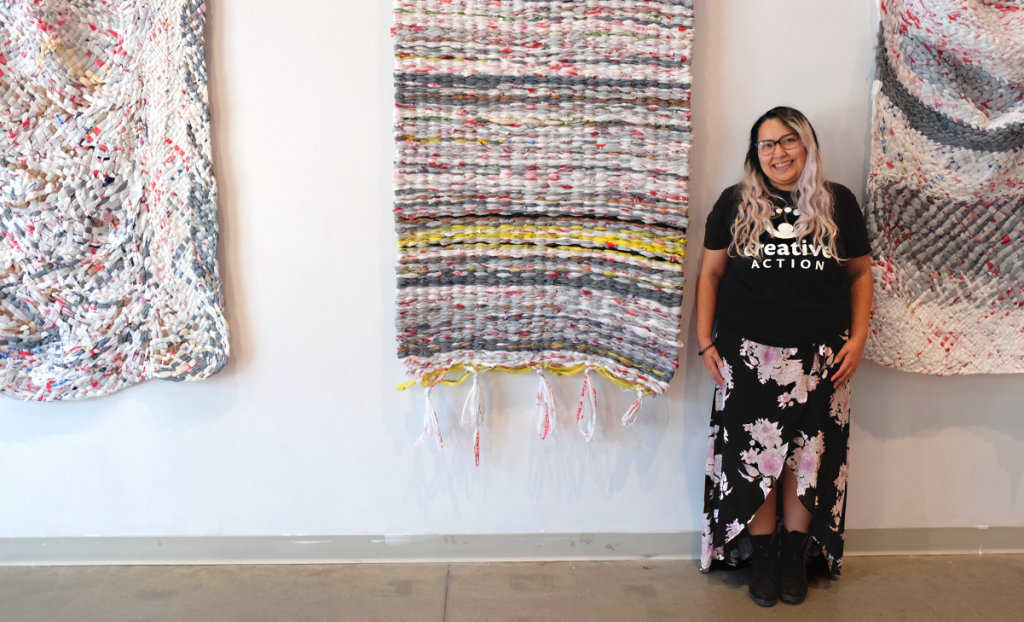
Kiana is currently looking for venues and partners to help her continue hosting community weaving circles. If you would like to support Kiana in continuing her project, please complete this form. To learn more about Austin's net-zero goal and the actions you can take to support a greener community, view the Austin Climate Equity Plan.
Share your Net-Zero contributions with us on X (formerly Twitter) or Facebook, and use #NetZeroHero. If you know a Net-Zero Hero (or heroes!) who should be recognized for their efforts, send your nomination to climate@austintexas.gov.

